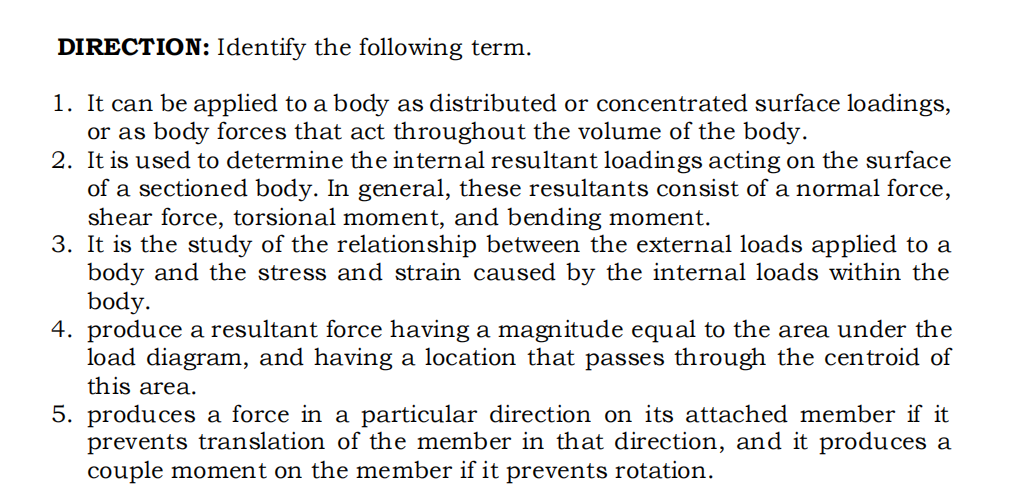DIRECTION: Identify the following term. 1. It can be applied to a body as distributed or concentrated surface loadings, or as body forces that act throughout the volume of the body. 2. It is used to determine the internal resultant loadings acting on the surface of a sectioned body. In general, these resultants consist of a normal force, shear force, torsional moment, and bending moment. 3. It is the study of the relationship between the external loads applied to a body and the stress and strain caused by the internal loads within the body. 4. produce a resultant force having a magnitude equal to the area under the load diagram, and having a location that passes through the centroid of this area. 5. produces a force in a particular direction on its attached member if it prevents translation of the member in that direction, and it produces a couple moment on the member if it prevents rotation.
DIRECTION: Identify the following term. 1. It can be applied to a body as distributed or concentrated surface loadings, or as body forces that act throughout the volume of the body. 2. It is used to determine the internal resultant loadings acting on the surface of a sectioned body. In general, these resultants consist of a normal force, shear force, torsional moment, and bending moment. 3. It is the study of the relationship between the external loads applied to a body and the stress and strain caused by the internal loads within the body. 4. produce a resultant force having a magnitude equal to the area under the load diagram, and having a location that passes through the centroid of this area. 5. produces a force in a particular direction on its attached member if it prevents translation of the member in that direction, and it produces a couple moment on the member if it prevents rotation.
Chapter2: Loads On Structures
Section: Chapter Questions
Problem 1P
Related questions
Question

Transcribed Image Text:DIRECTION: Identify the following term.
1. It can be applied to a body as distributed or concentrated surface loadings,
or as body forces that act throughout the volume of the body.
2. It is used to determine the internal resultant loadings acting on the surface
of a sectioned body. In general, these resultants consist of a normal force,
shear force, torsional moment, and bending moment.
3. It is the study of the relationship between the external loads applied to a
body and the stress and strain caused by the internal loads within the
body.
4. produce a resultant force having a magnitude equal to the area under the
load diagram, and having a location that passes through the centroid of
this area.
5. produces a force in a particular direction on its attached member if it
prevents translation of the member in that direction, and it produces a
couple moment on the member if it prevents rotation.
Expert Solution
This question has been solved!
Explore an expertly crafted, step-by-step solution for a thorough understanding of key concepts.
Step by step
Solved in 2 steps

Knowledge Booster
Learn more about
Need a deep-dive on the concept behind this application? Look no further. Learn more about this topic, civil-engineering and related others by exploring similar questions and additional content below.Recommended textbooks for you


Structural Analysis (10th Edition)
Civil Engineering
ISBN:
9780134610672
Author:
Russell C. Hibbeler
Publisher:
PEARSON

Principles of Foundation Engineering (MindTap Cou…
Civil Engineering
ISBN:
9781337705028
Author:
Braja M. Das, Nagaratnam Sivakugan
Publisher:
Cengage Learning


Structural Analysis (10th Edition)
Civil Engineering
ISBN:
9780134610672
Author:
Russell C. Hibbeler
Publisher:
PEARSON

Principles of Foundation Engineering (MindTap Cou…
Civil Engineering
ISBN:
9781337705028
Author:
Braja M. Das, Nagaratnam Sivakugan
Publisher:
Cengage Learning

Fundamentals of Structural Analysis
Civil Engineering
ISBN:
9780073398006
Author:
Kenneth M. Leet Emeritus, Chia-Ming Uang, Joel Lanning
Publisher:
McGraw-Hill Education


Traffic and Highway Engineering
Civil Engineering
ISBN:
9781305156241
Author:
Garber, Nicholas J.
Publisher:
Cengage Learning